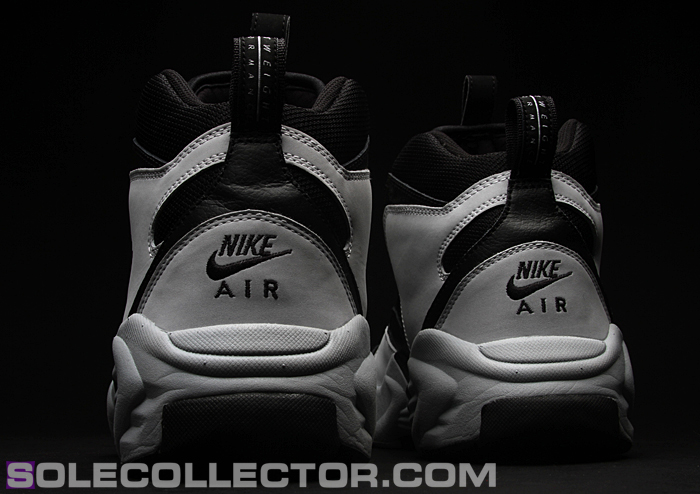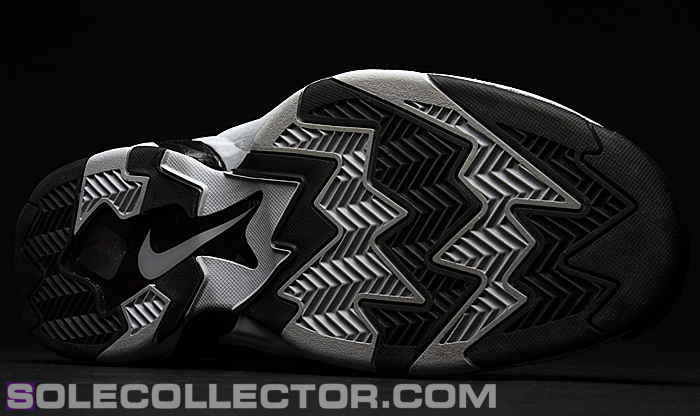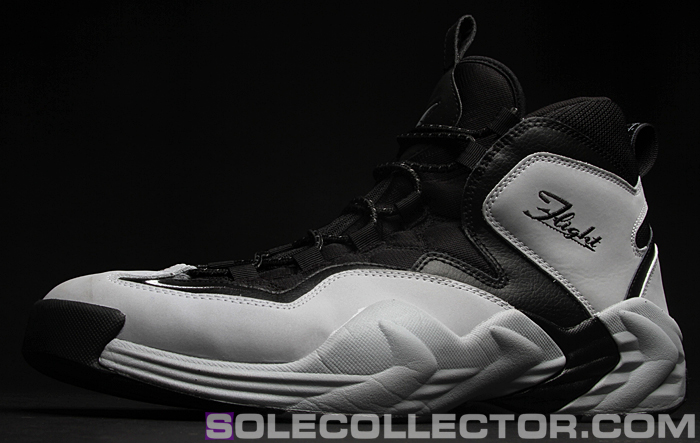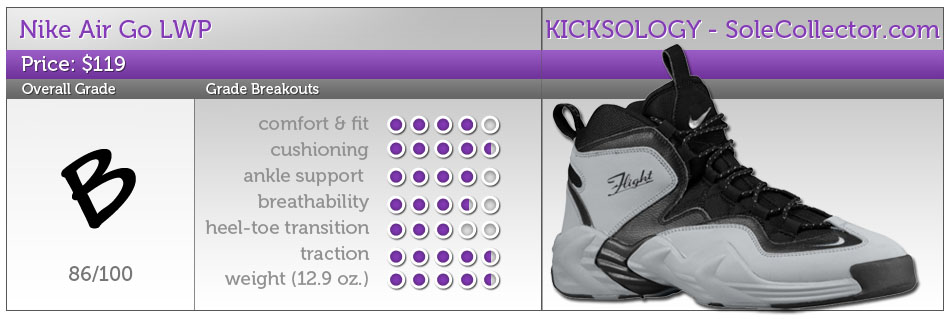Rose-Colored Glasses
words & images // Nick DePaula
The Air Go LWP has been an interesting, and for the most part, generational shoe, which I’ve gathered in the couple of months since it first saw a return. A return that for 15 years – to my generation, at least – was long overdue. While it’s an undeniable basketball classic to anyone over the age of 25, and in the top 10 for many even, the very first shoe to feature Nike’s Zoom Air and usher in a new era of lightweight performance hasn’t exactly lived on as a must-have for newer consumers and people less familiar with the shoe.
It’s a shoe that in its day was without a doubt the top performing basketball shoe on the market. Worn by the likes of both Penny and Tim Hardaway, my main man Mookie Blaylock and a sizable percentage of the rest of the league, it was light, sure, but also supportive, excellently cushioned and ideally speedy for guards. Just two summers ago, I routinely was even playing in an original pair.
 It was around that time, as the Hyperdunk hype and foot-hugging Kobe line began to take shape, that I began to realize that much like the current fanfare for the Go LWP, the shoe’s performance was also perhaps a generational thing. It was no doubt a thing of equal parts beauty and tuned innovation in 1994, but as all things evolve, what was once a great on-court option then is merely a nostalgic and above average performer by today’s standards.
It was around that time, as the Hyperdunk hype and foot-hugging Kobe line began to take shape, that I began to realize that much like the current fanfare for the Go LWP, the shoe’s performance was also perhaps a generational thing. It was no doubt a thing of equal parts beauty and tuned innovation in 1994, but as all things evolve, what was once a great on-court option then is merely a nostalgic and above average performer by today’s standards.
The LWP is still a fine basketball shoe, and even in our hyper-era of light, lighter and lightest, it’s still extremely light, but indeed there’s a case of looking through rose-colored glasses when playing in it. I remembered a shoe that was plush through the upper and both low to the ground and cushioned underfoot, with a heel Max Air unit and forefoot Zoom Air bag. After once again playing in the LWP in its Retro form and keeping in mind today’s top shoes, I began to notice that the forefoot has a bit of a flat feeling, as compared to the more sculpted toolings of today that promote better transition and flex. If you’re an open-court player, the LWP can at times feel a bit less than smooth when rolling from heel to toe.
Another noticeable difference between what made for a great shoe in 1994 and a standout in today’s modern world can be found in the LWP’s tongue construction. A full-length neoprene inner sleeve engulfs your foot upon entry, and is damn comfy to the touch. But while the plush fabric makes for a nice feel, the sleeve also lacks the shape and contour of today’s shoes that can tend to offer so much more in terms of fit, lockdown and that ideal feel of your foot and the shoe acting as one. Because of the excess fabric and ghilley eyelet setup, when lacing the shoe snuggly, the upper doesn’t exactly then pull closer to your foot. I could also use a traditional punched eyelet at the very top, rather than lacing through a ghilley, to lock in the lacing and fit just a bit more. If you’re used to the way that eyelets of today are anchored down to fully engage a shoe’s upper and offer more contour, the LWP may be a disappointment. At the time, the neoprene sleeve was a great solution for simple comfort, but as the years passed, we’ve seen less and less of a reliance on it, and mostly because it’s a less breathable and less fit-friendly material. Without question, it heats up immediately.

While the lack of toe spring through the forefoot and the less-than-locked-in inner sleeve were a bit of a letdown, the other highlights that made the LWP a great shoe in 1994 still hold true today. The shoe’s full-length herringbone pattern offers up outstanding traction on hardwood, and the heel Max Air unit is great for impact protection on landings and plants. The Zoom Air unit through the forefoot would have a better feel with a more sculpted tooling, but still gives that nice responsive pop that we all crave. Coupled with the shoe’s low stance is a great level of court feel and control, and as mentioned, the LWP still feels lightweight even after all these years of the industry taking us even lighter.
One simple note to mention is that I enjoyed playing in the grey and black synthetic leather-based colorway, but it might be worth a look at the black-based nubuck pairs if you plan to play in them, as the materials may flex better during play and require less of a break-in period.
 Overall, the Air Go LWP is still a very solid option for guards and swingmen alike, and it’s currently being worn in the NBA by Anthony Morrow of the New Jersey Nets and a few other players. If you’re after a lightweight, cushioned shoe that offers court feel and dependable traction, it should make for a great choice. If breathability, heel-to-toe transition and a lockdown fit through the collar and midfoot rank higher on your list, the LWP might pose a couple problems for you. It’s hard to truly fault a shoe that was ahead of its time in 1994 and at the forefront of a new era of performance basketball shoes, now that two decades later we have the luxury of more form-fitting heel counters, more sculpted midsoles and synthetic materials that can get the upper even lighter and closer to the foot. All in all, the LWP remains a solid basketball choice all these years later, and for guys like me, sometimes I’m willing to look through rose-colored glasses for the chance to re-live the performance of yesterday’s hoops classics.
Overall, the Air Go LWP is still a very solid option for guards and swingmen alike, and it’s currently being worn in the NBA by Anthony Morrow of the New Jersey Nets and a few other players. If you’re after a lightweight, cushioned shoe that offers court feel and dependable traction, it should make for a great choice. If breathability, heel-to-toe transition and a lockdown fit through the collar and midfoot rank higher on your list, the LWP might pose a couple problems for you. It’s hard to truly fault a shoe that was ahead of its time in 1994 and at the forefront of a new era of performance basketball shoes, now that two decades later we have the luxury of more form-fitting heel counters, more sculpted midsoles and synthetic materials that can get the upper even lighter and closer to the foot. All in all, the LWP remains a solid basketball choice all these years later, and for guys like me, sometimes I’m willing to look through rose-colored glasses for the chance to re-live the performance of yesterday’s hoops classics.
DETAILS & BUYING ADVICE:
designer: Eric Avar
best for: Guards & swift Forwards
colorway tested: Wolf Grey / Black
key tech: Heel Max Air, forefoot Zoom Air, full-length herringbone traction pattern and full-length neoprene inner-fit sleeve
pros: awesome lightweight comfort through upper and cushioning; nostalgia
cons: heel-to-toe transition is less smooth than ideal; ghilley eyelet system can loosen up during play
improvements: Add a little more toe spring to forefoot for better transition and less flat feel. Also, change top eyelet to punched eyelet for more secure lacing and fit.
buying advice: The Air Go LWP was in its a day a performance monster, breaking the 13 ounce mark and still offering outstanding cushioning and support. Unfortunately, that day was 1994, and the industry has since evolved to offer up even better lightweight options with even more cushioning, transition and lockdown. Still a solid choice for active players, the LWP is probably best suited for players who want to re-live an era of yesteryear with this re-issue of a classic Eric Avar design. If you’re after the best possible shoe on today’s market, you may want to look at the Hyperfuse, Air Jordan 2011 or adidas adiZero Rose.



